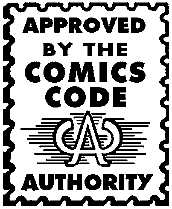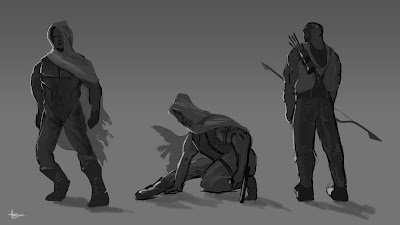Here is the first image that I produced when considering the city that my characters exist within. Looking back I am rather unhappy with the quality of this image, particularly in relation to the length of time it took. I wanted to portray the city as an open place where every action you take is visible to all, but feel I didn't really capture that as the buildings seem quite clustered and the windows aren't as large as I had intended. The only element I really like is the sinister billboard showing the capitalist hero. The slogan celebrates the way that the CEO monitors citizens "for their own protection". 'Watching over you' sounds wholesome and comforting, whereas beneath the charming text there are twisted intentions. It also shows the capitalist character as a brand, or a consumer commodity. He is trying to sell his ideologies, making us question whether he has genuine concern for anyone within the city.
I also wanted to consider other possible environments, so I produced some thumbnails:
The top two thumbnails are spaces that my vigilante would exist within, a sort of industrial wasteland on the edge of the city, and a sewer beneath all of the surveillance equipment. The top left concept is distorted by mist, and the sewer is a dark maze making them good locations to avoid being seen. The colours are cold, using the greens that we associate with vigilantes Green Arrow and Robin Hood, but also gives a certain sense of toxicity, communicating the vigilantes more dark shadow dwelling persona. It also could be taken as the notion of ugly truths. The environments the Vigilant lurks within aren't exactly pretty. The Bottom Capitalist environments on the other hand are much brighter and warmer. they feel much more open and visible, the office space giving a panoptic view of the city.
The necessity to produce an A2 poster for our final submission offered me and interesting opportunity to 'res up' and produce a higher quality image using some matte painting techniques. This next piece acts as my final image that ties together my character and environment elements, as well the backdrop for my academic poster. I wanted to depict a dramatic battle scene between the two central characters. To achieve a detailed and dramatic scene, I used lots of phototextures, and painted over them:

This image includes elements from my initial city concept, with the nostalgic billboards and warm colours. At this stage, I also began considering my narrative more. I had been toying with the idea of naming my city, but decided to heighten my narrative's relevance by setting it in 'New Manhattan'. I wanted to reflect post 9/11 agenda, but in an alternate reality where a similar catastrophe took place in Times Square leading to a heightened Military Industrial Complex, a theory on war and consumerism that I discuss in my essay. Similar to the impact the graphic novel and film adaptation 'V for Vendetta' had, I wanted my vigilante to be at the helm of a social revolution, his followers adopting the title 'The Sad Clowns'. I began naming my characters. I wanted my vigilante to have a wacky name, juxtaposing a comical title with a sense of despair, so I went with 'Dr. Desolation'. I went with the name Paul Bates for my rich CEO, calling his superhero alter ego 'The Warden'. This scene shows the aftermath of an explosion orchestrated by The Warden, as a means of thinning The Sad Clown's numbers at a demonstration, and framing them as Western hating suicide bombers.
With the presentation of my Academic Poster I initially had trouble with the text being legible over the image:
Here is a revised approach:
I was hoping to have the image more visible through the text boxes, but based on feedback and reflection, the legibility of the text proved more important. The approach of presenting an academic poster proved more enjoyable than a written evaluation. It inspired me to take on a more grand approach with my work, something tighter and more rendered. I was at this point planning on putting a cap on my practical work to focus solely on writing my extended essay. When I felt my essay was near completion however, I thought back to some of the thumb nails and decided that I could explore the space in which my characters exist more. This first concept shows another action scene. The aim was to create something fast with phototextures, achieving a level of detail that would take hours otherwise:

although I often feel I am cheating when relying heavily on phototextures, it is a useful practice to know when urgent visual development is required. I did spend time rendering out the explosions, which I feel adds a little bit more artistic credit to the image. Despite my apprehension, painting onto photographs is an enjoyable process nonetheless, trying to add in interesting light sources and allowing details the bleed through in places (in the case of this piece phototextures make up most of the composition).
Referring back to my thumbnails, I firstly wanted to expand on the visual look of the city. This time I tried a different approach with the colours:

This was another fairly fast and efficient piece. I wanted to reflect this theory of Panopticism, particularly with the strong reflective glass, as if these dominating corporate structures reveal everything, yet one cannot see inside the offices of those who occupy them. The billboard contains a sexy western woman, sporting a star spangled bikini, holding up duel glamourous military hardware. Again this links to heightened nostalgia, consumerism and the Military Industrial Complex. The clouds open up in such a way that they appear like a gigantic reptilian eye. On reflection, perhaps this concept would have been more effective if this eye in the sky had been directed more at the camera, as if scrutinising the viewer. Instead it feels as if it is looking down on the buildings, as I though at the time this would give the most interesting light source in a compositional sense.
For the final environment I considered the space that the vigilante might occupy. I wanted to expand on the sewer thumbnail:
With this image I stated chaotic working loosely in greyscale, rotating pieces of the composition and distorting the perspective until I started to see interesting shapes emerging. I do this sometimes to create interesting compositions. I went with this grungy ugly lighting of green and red to capture this dark and shady environment. I introduced the phototextures later hear, which I preferred as it meant that I already had a clear composition before throwing in too much confusing detail. The balloons and bunting further the mood, adding a playful edge to what is a grim space. The perspective is slightly off on the bridge that the vigilant stands before, but I feel this works rather well as a piece of concept art. This image took a little longer, but I am much happier with the results.


















